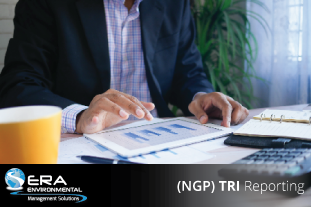
After assessing their activity, chemicals and information, the EPA has added natural gas processing (NGP) facilities to the list of TRI-covered industry sectors, making them subject to TRI reporting.
The first reports for NGP facilities are due July 1, 2023, which means that if you belong to this sector, you must promptly begin collecting 2022 TRI data (EPA, 2022).
What are NGP Facilities?Facilities classified as natural gas processing plants generally receive gas from offsite operations and process it by separating hydrocarbons and contaminants like hydrogen sulfide, carbon dioxide, and nitrogen to meet industry or pipeline requirements.
Natural gas purification methods include oil and condensate removal, water removal, separation of natural gas liquids, and sulfur and carbon dioxide removal. The EPA has determined that these processes might use, manufacture or process more than 25 TRI-listed chemicals, including hydrogen sulfide, benzene, toluene, ethylbenzene, and xylene.
What is NGP TRI Reporting?
The Toxic Release Inventory (TRI) report is an EPA requirement for industries in which they indicate how much of each regulated chemical is released to the environment or managed through recycling or energy recovery. The EPA now requires natural gas processing facilities to identify TRI-listed chemicals in their activities, check if they exceed the defined reporting thresholds, and report releases to the environment as well as waste management activities.
How Do Natural Gas Processing Facilities Meet the TRI reporting Criteria?
Currently, EPA estimates that more than 321 facilities on the list of natural gas processing plants in the United States meet the following criteria:
- The facility has ten or more full-time employees.
- The facility manufactures, processes, or otherwise uses a TRI-Listed chemical more than the reporting threshold. As mentioned above, NGP facilities may use, manufacture, or process many TRI-listed chemicals during the natural gas refining process.
- The facility is in a TRI-covered industry sector. The facility classification for NGPs is NAICS code 211130 (natural gas liquids) in SIC 1321 (natural gas liquids).
If your facility fits all the highlighted criteria, you are subject to TRI reporting next year.
The NGP TRI rule exempts facilities that only recover condensate, lease separation facilities that separate condensate from natural gas, or natural gas pipeline compressor stations. These processes are classified under a different NAICs code; for example, NAICS 221210 (Distribution of Natural Gas) making them exempt from TRI reporting (Federal Register., 2021).
Are Some NGP Facilities Already Reporting for TRI?
Yes, some NGP facilities were subject to TRI reporting before this rule. This is because they recover sulfur from natural gas, making them part of the “Industrial Inorganic Chemicals, Not Elsewhere Classified,” a manufacturing sector that already had TRI reporting requirements. They were only subject to reporting their sulfur extraction activities. If you belong to this group, you must now include your other TRI-listed chemicals and processes.
What Should I do Next?
Having to file an additional compliance report may seem daunting, but adequate preparation can spare you the hassle of last-minute data collection. According to the EPA, your next steps should include:
- Familiarizing yourself with TRI reporting criteria, types of chemicals, and thresholds.
- Learn and employ definitions of manufacture, process and otherwise use.
- Collecting your data on chemical releases, transfers, waste management and pollution prevention.
- Registering and preparing your TRI reporting Forms.
- Submitting your forms to the EPA for RY 2022 by July 1, 2023.
- Monitoring and following best practices at your facility for upcoming reports.
To learn more about TRI reporting, ERA has an exhaustive TRI reporting survival guide to help you with your data compilation.
References
- Environmental Protection Agency. (n.d.). EPA. Retrieved March 31, 2022, from https://www.epa.gov/toxics-release-inventory-tri-program/addition-natural-gas-processing-facilities-toxics-release#:~:text=Compliance-,Rule%20Summary,receive%20and%20refine%20natural%20gas.
- Federal Register:: Addition of natural gas processing … (n.d.). Retrieved April 1, 2022, from https://www.federalregister.gov/documents/2021/11/24/2021-25646/addition-of-natural-gas-processing-facilities-to-the-toxics-release-inventory.
This Blog was Co-Authored By:




Comments